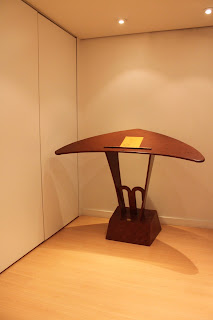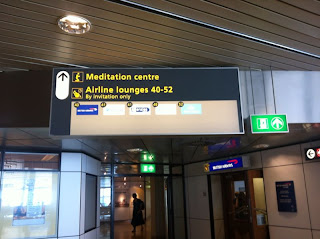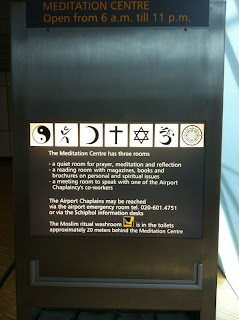This post was originally published on Muslimah Media Watch on 2 Dec 2013
A few weeks ago, I went to a small, local cinema in my city to catch a film. I’ve always liked going to this particular cinema because they screen international and independent films – a fresh change from the standard Hollywood fare at the bigger cinema.
The film was about to start, so I quickly ducked into the ladies’. After I washed my hands, imagine my shock at seeing the following poster pasted behind the door:
The text on the poster says (in Dutch):
When I posted this picture and my reaction on Facebook, bemoaning the use of a veiled brown woman to homogenise and represent developing countries as homophobic, I received an interesting reaction from a white Dutch woman.
This acquaintance made a clear comparison between “Islamic countries” and Holland. Illustrating her argument with a story that her daughter is lesbian and is able to live a perfectly heteronormative life (hoping to marry, have children and build a household), she stated that she was glad that her daughter was born in Holland and not in “Islamic countries”.
I believe this is the main reaction that the poster intends to arouse in its main viewers – middle class white Dutch people who wish to help those in developing countries: that they should feel grateful for the “freedom” and “tolerance” in the Netherlands and extend their generosity to other countries that are not as “free”.
Attempts by fellow queer Muslim women to add nuance to her argument only led to a flat out denial of any marginalisation of LGBTQ groups (for example, those of colour) in the Netherlands, and her reinforcement of the idea that Islam is (and Muslims are) inherently homophobic. In fact, she even accused me of not being sufficiently “tolerant” because I found her category of homophobic “Islamic countries” to be reinforcing stereotypes and erasing complex socio-political histories.
I still wonder about the logic behind this campaign by Hivos. What do they mean, exactly, that this “veiled lady symbolises the difficult fight against homophobia”? That all Muslims are homophobic? That all countries with Muslim laws are homophobic? That LGBTQ Muslims always want to come out? That LGBTQ Muslims need the support and solidarity from development organisations in the Global North to help them?
Further reading reveals that Hivos holds the hegemonic, liberal feminist idea that “the position of lesbian women as a measure of freedom” can and must be applied to all countries. However, such an universal idea of freedom has already been sharply critiqued, interrogated and questioned by women scholars such as Saba Mahmood,Gayatri Spivak and Lila Abu-Lughod.
As I found out, the woman in the poster is not even Muslim.
The woman in the picture is in fact Papu, a Bhopa woman from the Thar desert in Rajasthan, India, photographed by Mirjam Letsch, a Dutch photographer. In fact, in some areas in rural north India, married Hindu women veil themselves in front of certain people like older male in-laws. According to the website set up by the photographer, Papu has a husband, children, and supports her family by playing music on the streets. Most importantly, the Papu Photo Project was actually set up to support Indian “dowry victims” – women who are mutilated, set on fire, or killed for not being able to provide sufficient dowry. Not LGBTQ women who are unable to come out.
This campaign was selected in 2011 for a charity awards competition by NRC, a Dutch newspaper. Taking a quick look at the website of this year’s awards, I found another example of the use of the image of a brown woman in hijab as a way to catch the viewer’s attention, using stereotypes about Muslims.
The text on the poster by Antoni van Leeuwenhoek Foundation below says “I am against equal treatment” (presumably, of men and women). This poster plays on the stereotype that Muslims (and especially Muslim women in hijab) are never for gender equality, unlike white Dutch people – ignoring and erasing the work of Dutch Muslim organisations and platforms that believe in gender equality such as Al Nisa and Nieuwe Moskee. It turns out upon closer inspection of the text, that the ad is about cancer treatment.
In one article on their website, Hivos mentions the arrests and legal penalties for gay/lesbian people in Malawi and Uganda (perhaps more relevant to another poster from the same campaign, which pictures a black man with the words “I’m gay” ). According to Hivos, these incidents justify the use of the image of an Indian woman (so they do know that she’s Indian!).Hivos adds in the same article that “whether or not this lady herself is a lesbian, does not matter”.
A few weeks ago, I went to a small, local cinema in my city to catch a film. I’ve always liked going to this particular cinema because they screen international and independent films – a fresh change from the standard Hollywood fare at the bigger cinema.
The film was about to start, so I quickly ducked into the ladies’. After I washed my hands, imagine my shock at seeing the following poster pasted behind the door:
 |
| Source: Hivos |
“This woman is a symbol for all homosexual women and men in developing countries that, through Hivos’s human rights programme, can come out about their orientation.”Another version of the poster has a slightly different text, and ends on an appeal for donations:
“There are countries where people cannot say what they want, and cannot be who they are. Hivos, a development organisation, wants to give a voice to as many of these people as possible. Because everyone should be able to be, and say, what he or she wants. Support Hivos GIRO 1969.”As you might imagine, my shock was not so much “OMG a Muslimwoman is lesbian” but “OMG misuse of images of veiled women (yet again)!”
When I posted this picture and my reaction on Facebook, bemoaning the use of a veiled brown woman to homogenise and represent developing countries as homophobic, I received an interesting reaction from a white Dutch woman.
This acquaintance made a clear comparison between “Islamic countries” and Holland. Illustrating her argument with a story that her daughter is lesbian and is able to live a perfectly heteronormative life (hoping to marry, have children and build a household), she stated that she was glad that her daughter was born in Holland and not in “Islamic countries”.
I believe this is the main reaction that the poster intends to arouse in its main viewers – middle class white Dutch people who wish to help those in developing countries: that they should feel grateful for the “freedom” and “tolerance” in the Netherlands and extend their generosity to other countries that are not as “free”.
Attempts by fellow queer Muslim women to add nuance to her argument only led to a flat out denial of any marginalisation of LGBTQ groups (for example, those of colour) in the Netherlands, and her reinforcement of the idea that Islam is (and Muslims are) inherently homophobic. In fact, she even accused me of not being sufficiently “tolerant” because I found her category of homophobic “Islamic countries” to be reinforcing stereotypes and erasing complex socio-political histories.
I still wonder about the logic behind this campaign by Hivos. What do they mean, exactly, that this “veiled lady symbolises the difficult fight against homophobia”? That all Muslims are homophobic? That all countries with Muslim laws are homophobic? That LGBTQ Muslims always want to come out? That LGBTQ Muslims need the support and solidarity from development organisations in the Global North to help them?
Further reading reveals that Hivos holds the hegemonic, liberal feminist idea that “the position of lesbian women as a measure of freedom” can and must be applied to all countries. However, such an universal idea of freedom has already been sharply critiqued, interrogated and questioned by women scholars such as Saba Mahmood,Gayatri Spivak and Lila Abu-Lughod.
As I found out, the woman in the poster is not even Muslim.
The woman in the picture is in fact Papu, a Bhopa woman from the Thar desert in Rajasthan, India, photographed by Mirjam Letsch, a Dutch photographer. In fact, in some areas in rural north India, married Hindu women veil themselves in front of certain people like older male in-laws. According to the website set up by the photographer, Papu has a husband, children, and supports her family by playing music on the streets. Most importantly, the Papu Photo Project was actually set up to support Indian “dowry victims” – women who are mutilated, set on fire, or killed for not being able to provide sufficient dowry. Not LGBTQ women who are unable to come out.
 |
| Source: NRC Charity Awards |
The text on the poster by Antoni van Leeuwenhoek Foundation below says “I am against equal treatment” (presumably, of men and women). This poster plays on the stereotype that Muslims (and especially Muslim women in hijab) are never for gender equality, unlike white Dutch people – ignoring and erasing the work of Dutch Muslim organisations and platforms that believe in gender equality such as Al Nisa and Nieuwe Moskee. It turns out upon closer inspection of the text, that the ad is about cancer treatment.
This is exactly the purpose of the image of the veiled Rajasthani woman on the Hivos poster. By juxtaposing an image of what seems to be a Muslim woman from a developing country together with the text “I am lesbian”, the organisation intends to get the attention of a certain kind of viewer. This viewer is assumed to believe that Muslims are homophobic because LGBTQ Muslims are oppressed (only) by religion, and that homophobia is a problem of developing countries and not countries with lots of “freedom” like the Netherlands.
The poster in fact merely reinforces the self-image of white Dutch people, helping them feel good about themselves (which they then act upon by hopefully donating some money).
 |
| Source: Author's own photo |
However, it matters because 1) the text says “I am lesbian”, and 2) it means that the organisation is playing on the stereotypes of a veiled woman, without caring if the woman herself is lesbian.
Is it a stretch of the imagination to feature an actual lesbian brown woman, whether Hindu or Muslim, for a really effective campaign? These two posters in effect racialise LGBTQ issues as a problem of “others” in “developing countries” and not “at home”. More importantly, why claim to support one marginalised group while further marginalising another?
Is it a stretch of the imagination to feature an actual lesbian brown woman, whether Hindu or Muslim, for a really effective campaign? These two posters in effect racialise LGBTQ issues as a problem of “others” in “developing countries” and not “at home”. More importantly, why claim to support one marginalised group while further marginalising another?

























